
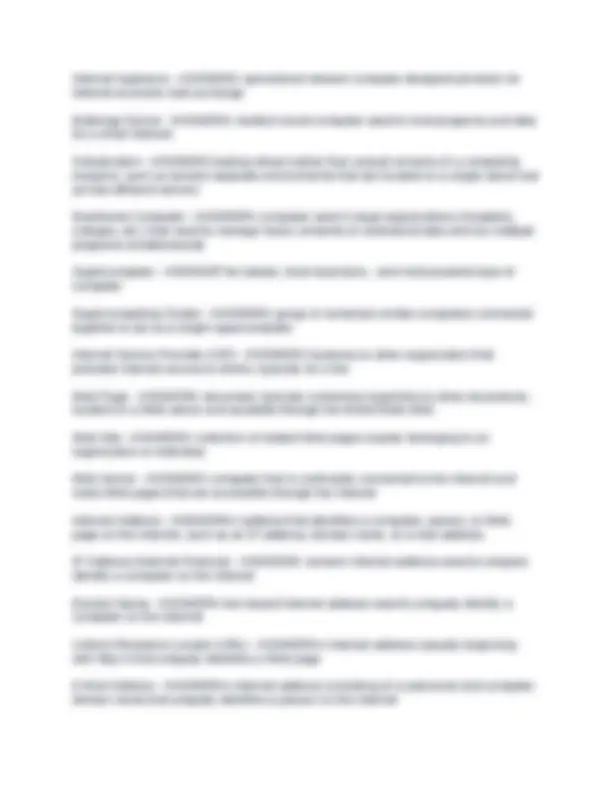
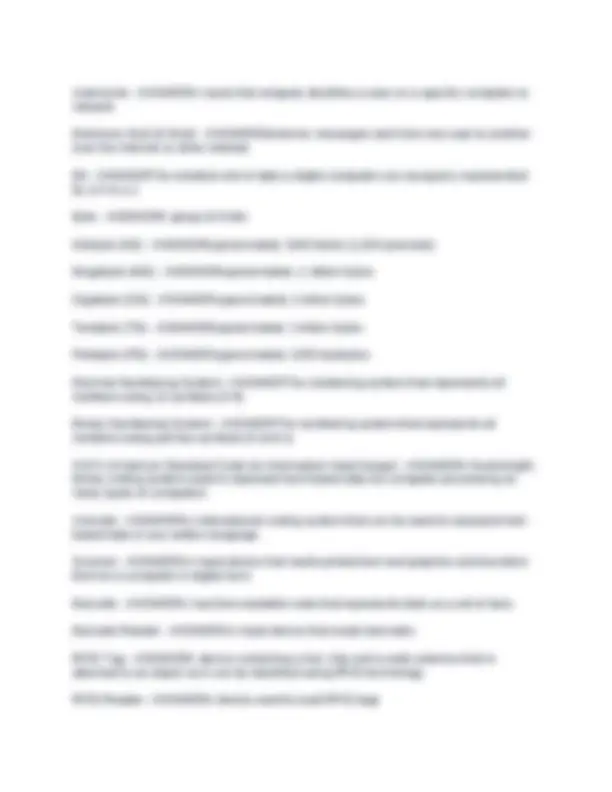
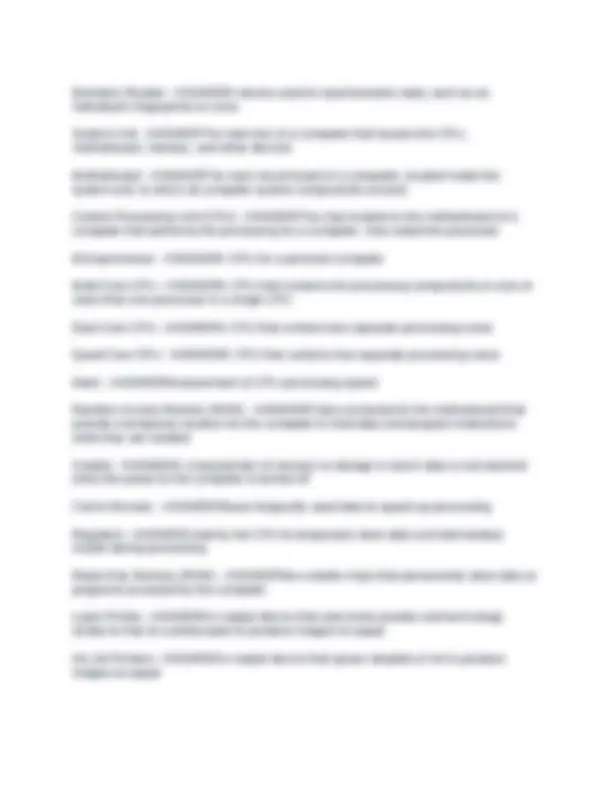
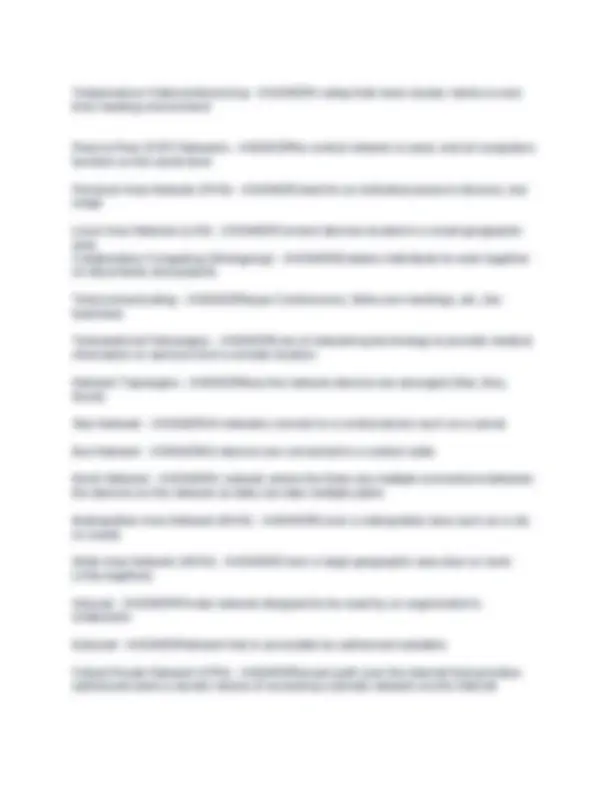
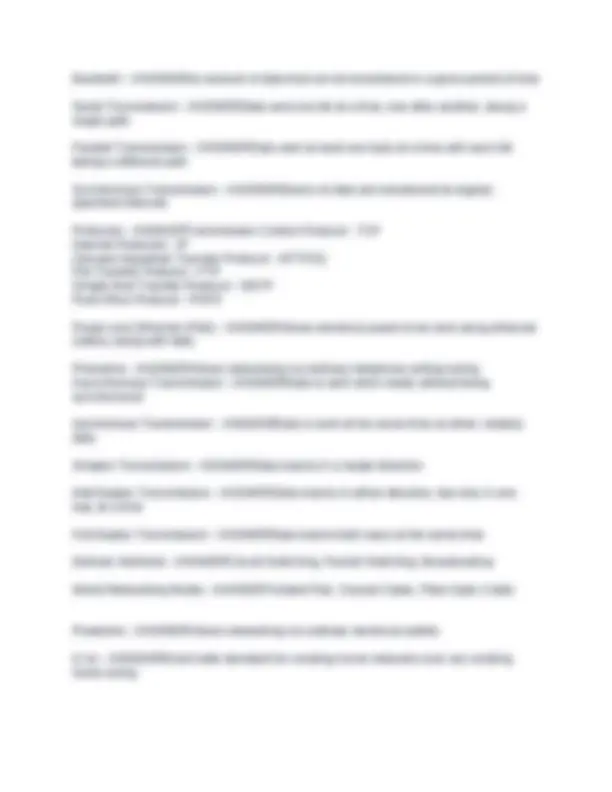
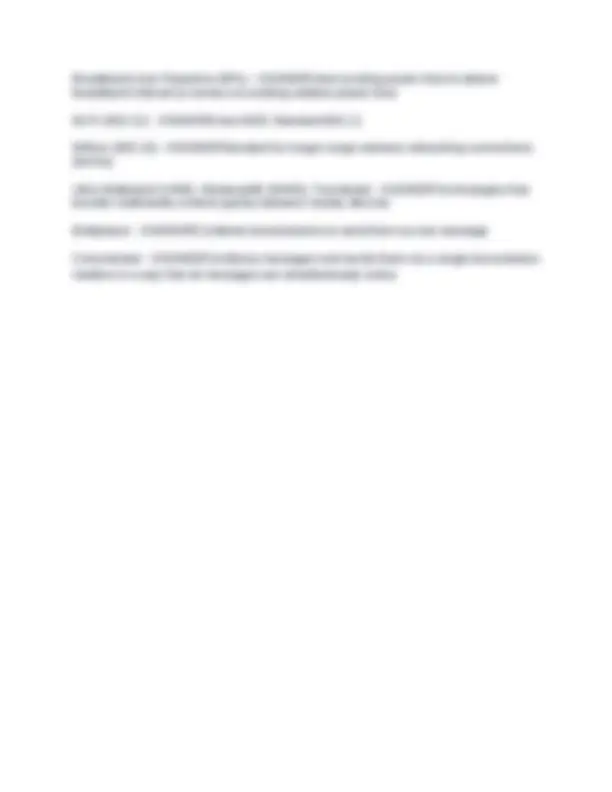


Study with the several resources on Docsity

Earn points by helping other students or get them with a premium plan


Prepare for your exams
Study with the several resources on Docsity

Earn points to download
Earn points by helping other students or get them with a premium plan
Community
Ask the community for help and clear up your study doubts
Discover the best universities in your country according to Docsity users
Free resources
Download our free guides on studying techniques, anxiety management strategies, and thesis advice from Docsity tutors
Computer Literacy - ANSWERKnowing about and understanding computers and their uses Computer - ANSWERA programmable, electronic device that accepts data, performs, operations on that data, presents the results, and stores the data/results as needed Hardware - ANSWERThe physical parts of a computer system Software - ANSWERThe instructions (aka computer programs) used to tell a computer what it should do. Operating System - ANSWERThe main component of system software that enables the computer to operate, manage its activities and the resources under its control, run application programs, and interface with the user Windows Desktop - ANSWERThe background work area displayed on the screen for computers running Microsoft Windows Application Software
Typology: Exams
1 / 10

This page cannot be seen from the preview
Don't miss anything!







Computer Literacy - ANSWERKnowing about and understanding computers and their uses Computer - ANSWERA programmable, electronic device that accepts data, performs, operations on that data, presents the results, and stores the data/results as needed Hardware - ANSWERThe physical parts of a computer system Software - ANSWERThe instructions (aka computer programs) used to tell a computer what it should do. Operating System - ANSWERThe main component of system software that enables the computer to operate, manage its activities and the resources under its control, run application programs, and interface with the user Windows Desktop - ANSWERThe background work area displayed on the screen for computers running Microsoft Windows Application Software - ANSWERPrograms that enable users to perform specific tasks on a computer Embedded Computer - ANSWERA tiny computer embedded in a product and designed to perform specific tasks or functions for that product Personal Computer (PC) - ANSWERA type of computer based on a microprocessor and designed to be used by one person at a time (aka microcomputer) Portable Computer - ANSWERA small personal computer (notebook, tablet, netbook) that is designed to be carried around easily Notebook (Laptop) Computer - ANSWERA fully functioning portable computer that opens to reveal a screen and keyboard Tablet Computer - ANSWERA portable computer about the size of a notebook that is designed to be used with a digital pen Netbook - ANSWERA very small notebook computer Thin Client (Network Computer - NC) - ANSWERA personal computer designed to access a network for processing and data storage, instead of performing those tasks locally
Username - ANSWERA name that uniquely identifies a user on a specific computer or network Electronic Mail (E-Mail) - ANSWERElectronic messages sent from one user to another over the Internet or other network Bit - ANSWERThe smallest unit of data a digital computer can recognize; represented by a 0 or a 1 Byte - ANSWERA group of 8 bits Kilobyte (KB) - ANSWERApproximately 1000 bytes (1,024 precisely) Megabyte (MB) - ANSWERApproximately 1 million bytes Gigabyte (GB) - ANSWERApproximately 1 billion bytes Terabyte (TB) - ANSWERApproximately 1 trillion bytes Petabyte (PB) - ANSWERApproximately 1000 terabytes Decimal Numbering System - ANSWERThe numbering system that represents all numbers using 10 symbals (0-9) Binary Numbering System - ANSWERThe numbering system that represents all numbers using just two symbols (0 and 1) ASCII (American Standard Code for Information Interchange) - ANSWERA fixed-length, binary coding system used to represent text-based data for computer processing on many types of computers Unicode - ANSWERAn international coding system that can be used to represent text- based data in any written language Scanner - ANSWERAn input device that reads printed text and graphics and transfers them to a computer in digital form Barcode - ANSWERA machine-readable code that represents data as a set of bars Barcode Reader - ANSWERAn input device that reads barcodes RFID Tag - ANSWERA device containing a tiny chip and a radio antenna that is attached to an object so it can be identified using RFID technology RFID Reader - ANSWERA device used to read RFID tags
Biometric Reader - ANSWERA device used to input biometric data, such as an individual's fingerprints or voice System Unit - ANSWERThe main box of a computer that houses the CPU, motherboard, memory, and other devices Motherboard - ANSWERThe main circuit board of a computer, located inside the system unit, to which all computer system components connect Central Processing Unit (CPU) - ANSWERThe chip located on the motherboard of a computer that performs the processing for a computer. Also called the processor Microprocessor - ANSWERA CPU for a personal computer Multi-Core CPU - ANSWERA CPU that contains the processing components or core of more than one processor in a single CPU Dual-Core CPU - ANSWERA CPU that contains two separate processing cores Quad-Core CPU - ANSWERA CPU that contains four separate processing cores Hertz - ANSWERMeasurement of CPU processing speed Random Access Memory (RAM) - ANSWERChips connected to the motherboard that provide a temporary location for the computer to hold data and program instructions while they are needed Volatile - ANSWERA characteristic of memory or storage in which data is not retained when the power to the computer is turned off Cache Memory - ANSWERStores frequently used data to speed up processing Registers - ANSWERUsed by the CPU to temporarily store data and intermediary results during processing Read-Only Memory (ROM) - ANSWERNon-volatile chips that permanently store data or programs accessed by the computer Laser Printer - ANSWERAn output device that uses toner powder and technology similar to that of a photocopier to produce images on paper Ink-Jet Printers - ANSWERAn output device that sprays droplets of ink to produce images on paper
Smart Card - ANSWERA credit card-sized piece of plastic containing a chip and other circuitry that can store data Ribbon - ANSWERA feature found in recent versions of Microsoft Office that uses tabs to organize groups of related commands Computer Network - ANSWERA collection of computers and other hardware devices connected together so users can share hardware, software, data, and communicate Telephone Service - ANSWERPOTS Network - One of the first networks Dual-Mode Phones - ANSWERAllows users to make calls using more than one communications network Communications Device - ANSWERA piece of hardware that allows one device to communicate with other devices via a network or the Internet Network Adapter - ANSWERA network interface, such as an expansion card or external network adapter Modem - ANSWERA device that enables a computer to communicate over telephone lines Software License - ANSWERAn agreement that specifies the conditions under which a buyer of the program can use it Five Types of Software - ANSWERCommercial, Shareware, Freeware, Public Domain, and Open Source Installed Software - ANSWERSoftware that must be installed on a computer in order to be used Web-Based Software - ANSWERSoftware that is delivered on demand via the Web (Software as a Service - SaaS, Cloudware) Global Position System (GPS) Applications - ANSWERUses satellites and receivers to determine the exact location of the receiver Sensor Networks - ANSWERDevices that respond to heat, light, pressure and generate a measurable electrical signal Multimedia Network - ANSWERDistributing digital multimedia content, typically via a home network Placeshifting Content - ANSWERAllows individuals to view multimedia content at a more convenient location
Telepresence Videoconferencing - ANSWERA setup that more closely mimics a real- time meeting environment Peer-to-Peer (P2P) Networks - ANSWERNo central network is used, and all computers function on the same level Personal Area Network (PAN) - ANSWERUsed for an individual person's devices, low range Local Area Network (LAN) - ANSWERConnect devices located in a small geographic area Collaborative Computing (Workgroup) - ANSWEREnables individuals to work together on documents and projects Telecommunicating - ANSWERSkype Conferences, Web-cam meetings, etc. (for business) Telemedicine/Telesurgery - ANSWERUse of networking technology to provide medical information or services from a remote location Network Topologies - ANSWERHow the network devices are arranged (Star, Bus, Mesh) Star Network - ANSWERAll networks connect to a central device such as a server Bus Network - ANSWERAll devices are connected to a central cable Mesh Network - ANSWERA network where the there are multiple connections between the devices on the network so data can take multiple paths Metropolitan Area Network (MAN) - ANSWERCover a metropolitan area such as a city or county Wide Area Network (WAN) - ANSWERCover a large geographic area (two or more LANs together) Intranet - ANSWERPrivate network designed to be used by an organization's employees Extranet - ANSWERNetwork that is accessible by authorized outsiders Virtual Private Network (VPN) - ANSWERSecure path over the internet that provides authorized users a secure means of accessing a private network via the Internet
Broadband over Powerline (BPL) - ANSWERUses existing power lines to deliver broadband Internet to homes via existing outdoor power lines Wi-Fi (802.11) - ANSWERUses IEEE Standard 802. WiMax (802.16) - ANSWERStandard for longer range wireless networking connections (MANs) Ultra Wideband (UWB), WirelessHD (WiHD), Transferjet - ANSWERTechnologies that transfer multimedia content quickly between nearby devices Multiplexer - ANSWERCombines transmissions to send them as one message Concentrator - ANSWERCombines messages and sends them via a single transmission medium in a way that all messages are simultaneously active